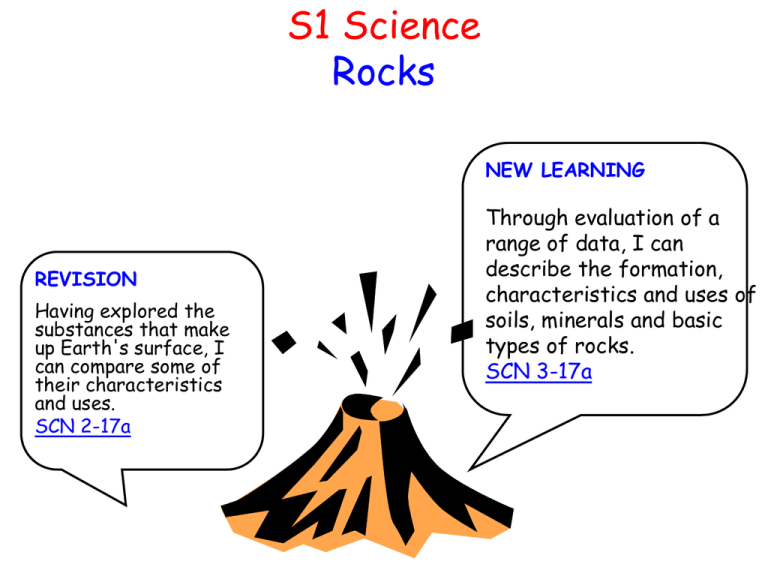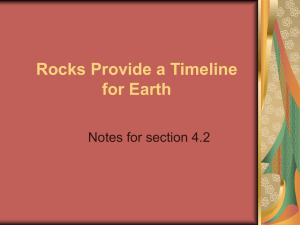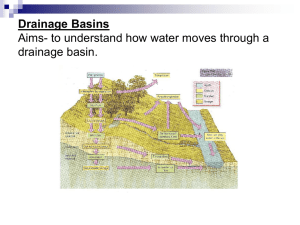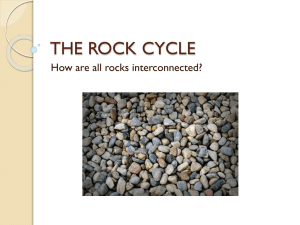Rocks_PPT - Lesmahagow High School
advertisement

S1 Science Rocks NEW LEARNING REVISION Having explored the substances that make up Earth's surface, I can compare some of their characteristics and uses. SCN 2-17a Through evaluation of a range of data, I can describe the formation, characteristics and uses of soils, minerals and basic types of rocks. SCN 3-17a Starter Questions 1. What do you think the Earth is made of? 2. Are rocks: Alive, Dead or Never Alive? 3. Write down 3 words to describe rocks. Structure of the Earth Today we will learn to Describe the layers which make up planet Earth We will do this by Listening to a description, drawing a diagram and answering questions. We will have succeeded if We can describe the Earth to an alien (or our parents!). Inside the Earth Inside the Earth Inside the Earth • Inner Core: Mostly iron, dense ________, temperature about ________! • Outer Core: Mostly iron, dense ________, temperature about__________. • Mantle: Less dense than _________, temperature about ________. • Crust: Between __ and 90km thick. Least dense rock, __________ part. • Today we’ll be….. • Learning how different types of rock form. • By the end of the next couple of lessons... • You will be able to explain how crystals form inside rocks • We’ll do this by…. • Examining different rock types, watching a film about how they form, and answering some questions. Weathering breaks down rocks. igneous rocks volcano basalt Magma rises to the surface where it cools rapidly. Rocks rise to the surface by uplift and erosion. igneous rocks granite slow solidification magma melt transportation and deposition sea sedimentary rocks mudstone high pressure and temperature metamorphic rocks slate and marble • Today we’ll be….. • Learning how crystals form in igneous rock. • By the end of the lesson... • You will be able to explain why crystals in rock are different sizes. • We’ll do this by…. • Doing an experiment to cool hot liquid and examining what it looks like afterwards. Crystals in Igneous Rock Crystals in Igneous Rock Crystals in Igneous Rock • The crystals in _______ rock form as the hot m_______ (lava) cools down. • Different sized crystals form because the magma _______ at different rates in different places, dependent on the t__________. Crystals in Igneous Rock • The crystals in igneous rock form as the hot magma (lava) cools down. • Different sized crystals form because the magma cools at different rates in different places, dependent on the temperature. Sedimentary Rocks How They are Made • Wind and water break down existing rocks • Bits of existing rock settle in lakes and rivers • Layers are formed and build up as the existing rocks stick together • Pressure and time turn the layers to sedimentary rock Types of Sedimentary Rocks Sandstone Mudstone Gypsum Rock Salt Limestone Coal Metamorphic Rocks What are They? • • • • Rocks that have changed They were once igneous or sedimentary Pressure and heat changed the rocks The newly formed metamorphic rock can have different properties to the rock it was formed from Types of Metamorphic Rocks Gneiss marble Slate Mica schist Rocks Have Been Used For Many Years and For Many Things What type of Rock are the following made from ? The White House Taj Mahal Made from sandstone then painted white Made from Indian marble S1 Earth & Rocks Topic HARD ROCK INVESTIGATION • Today we’ll be….. • Learning how fossils form in sedimentary rock. • By the end of the lesson... • You will be able to explain how fossils were preserved on the sea bed. • We’ll do this by…. • Doing an experiment to look at how fossils were preserved and discussing fossils Has our country always been here? http://www.bbc.co.uk/learningzone/clips/fossils-on-streedagh-beach-in-ireland/7792.html • Most of our country is made from sedimentary rock – what does this tell you? • Our land was once underwater! Fossils • Fossils are traces of prehistoric life • They are plants or animals that were buried in sediment and preserved • Usually it was the print that was left – the rock in the shape of the animal or plant • The types of fossils in an area give clues to the area’s history Making fossils – 1 between 2 • Put your initials on the cardboard and tape your cardboard in a circle • Put plasticine in the bottom of the cardboard and make an impression of your shell in this – this is your mould • Add 40ml of water to the plaster of paris – gently squeeze the bag until all of the water is gone • Pour the plaster into your mould and leave it on the window ledge to set • Today we’ll be….. • Learning what soil is made of. • By the end of the lesson... • You will be able to explain what the three main components of soil are. • We’ll do this by…. • Doing an experiment to heat soil and weighing it before and after. Soil • What do you think of soil? • It doesn’t look like much, but it is full of life • http://www.bbc.co.uk/learningzone/clips /what-is-soil/2215.html Soil Calculation Composition of Soil 1 2 3 4 5 6 7 Weight of empty dish Weight of dish and soil Weight of soil (2-1) Weight of dish and dry soil Weight of water (2-4) Weight of dish and burned soil Weight of humus (4-6) g g g g g g g Percentage of water in soil = [Weight of water/weight of soil] x 100 = [5/3]x100 = ________x100 = %









